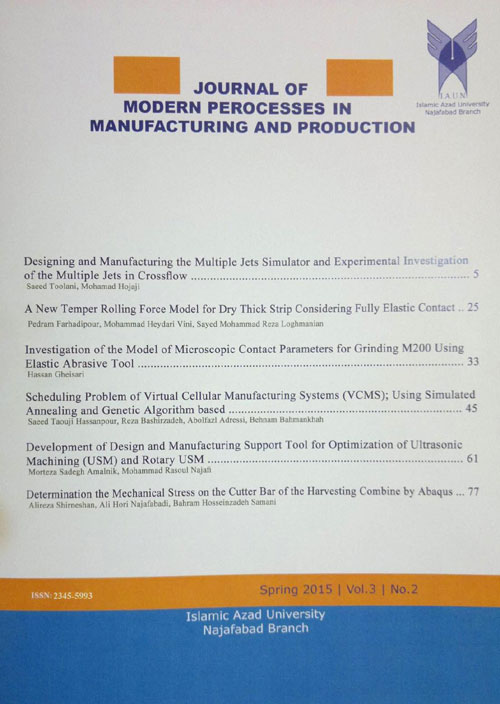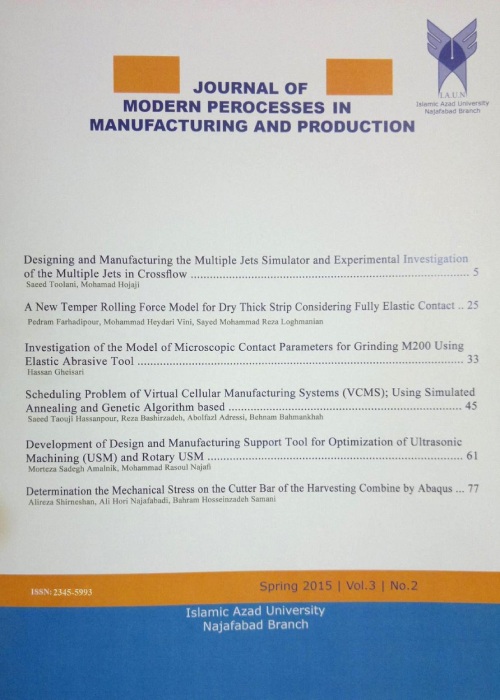فهرست مطالب

Journal of Modern Processes in Manufacturing and Production
Volume:10 Issue: 1, Winter 2021
- تاریخ انتشار: 1400/03/30
- تعداد عناوین: 6
-
-
Pages 5-18Today, one of the new approaches of researchers to produce materials with very fine grains is the application of severe plastic deformation on the prototype with coarse grains. In this method, the grain size is reduced to the nanometer scale in several stages through applying strong strains to the sample, which leads to the improvement of mechanical and physical properties in the material. One of the most important methods of applying severe plastic deformation is the constrained groove pressing (CGP) process. According to studies, little research has been done on the weight loss of structures used in the military, maritime, aviation, and medical industries. Therefore, the mechanical behavior of the sheets was experimentally studied by the CGP method. The results show that the structure of 7075-T6 aluminum particles decreased in size from 60 microns to 270 nanometers by increasing the steps of this process. Also, the yield strength in the fourth pass increased by 38% compared to the annealed sample, and the tensile strength improved by 34%. In addition, the percentage of longitudinal increases in the fourth pass is reduced to its lowest value, ie 40%.Keywords: Constrained Groove Pressing Process, 7075 aluminum alloy, Ultrafine-grained Materials, Mechanical Properties
-
Pages 19-30In this study, polyamide 6 (PA6)/ nitrile butadiene rubber (NBR) based hybrid-nanocomposites reinforced with calcium carbonate and organo-clay as nanofillers in various content of 1, 3 and 5 phr were prepared and characterized. The nanocomposite samples were prepared through the melt processing method in an internal mixer. The effect of rubber phase (NBR) content (10, 30, and 50 wt.%), calcium carbonate content (1, 3, and 5 phr), and organo-clay content (1, 3, and 5) was investigated on morphology and mechanical properties of the nanocomposites. The mechanical properties were evaluated by tensile, flexural, and Charpy impact tests. The results showed that adding the NBR reduces the tensile strength, tensile modulus, flexural strength, and flexural modulus, and increases the impact strength. Introducing the nano-clay and calcium carbonate improves the tensile and flexural strength, tensile and flexural modulus, and decreases the impact strength. The nano-clay content from 1 to 3 phr improved the impact strength.Keywords: Polyamide 6, Nitrile Butadiene Rubber, Organo-clay, Calcium carbonate, Mechanical Properties
-
Pages 31-50Service robots are one of the most critical robot's applications that enter human life. This domain consists of elements from human health to industry. Somehow, this robot type can save a human's life or help him secure from the load-carrying job and all repeated work that may interfere with job accuracy. Based on ISO 8373:2012 The service robots Split into personal service types of robots characteristically meant to use outside of manufacturing and the professional setting robots and professional service robots that can use as non-commercial individuals professional service robots can use as commercial professionals. Even as the service robot development research has shown various new service robots with specific ability proposed, some parts in these robot types are similar and are day by day extended. MIR and AGV robots are the most famous service robot with dual ability in the industry and the home applicant. This paper covers most of the papers published on the MIR platform to address the detailed design and part of these types, which can be useful for industries and researchers. The most significant thing that has been done through this review is a service robot design. On the other hand, the researcher has more investigation on the service robot application and has study the MIR Industrial/service robot platform.Keywords: Service Robot, AGV, MIR, Industrial Applications, Design
-
Pages 51-61Reduction of weight and increase of corrosion resistance are among the advantages of applications of aluminum alloys in the automotive industry. Low formability at room temperature is the major problem in the forming of these alloys. This problem is due to alloy elements that limit the number of slip planes at room temperature. Forming at a high temperature can improve the formability of metals. In this paper, the warm hydroforming of AA1050 aluminum tubes has been studied numerically. A warm tube hydroforming setup was designed and fabricated. Aluminum tubes were formed at high temperatures. Numerical simulation of process is performed using MSC. Marc commercial software and thickness distribution were studied at various temperatures. Results showed that increasing temperature leads to a much better thickness distribution. The pressure curves which were obtained using available equations for forming at room temperature have been modified to decrease thinning in the final part. Simulations were performed in two states which are called constrained bulge and free bulge. To produce a part without any wrinkling and also to obtain minimum thinning, an axial feeding curve is suggested.Keywords: Warm Tube Hydroforming, Finite Eelement Method (FEM), Aluminum alloy
-
Pages 63-76Today, germanium single-crystals are used as an infrared and semiconductor material in the manufacturing of infrared optical lenses and windows (thermal vision), gamma-ray detectors, and substrates for optoelectronic and electronic applications. Given that germanium is an optically brittle material with high brittleness and brittle failure that mainly affects the surface integrity of the machined part on this material; In this experimental study, by changing the rake angle and feed rate of the cutting tool, experiments were performed to determine the appropriate rake angles and suitable feed rates and their effects on the surface roughness and texture of the relevant surface for germanium turning in the dry state. The results show that with increasing the rake angle and decreasing the feed rate of the cutting tool, the surface roughness decreases, which reduces the surface damage to a considerable extent. The purpose of this experimental study is to create a surface with the desired quality in the machining process of the germanium optical part using ductile mode machining and to change the parameters of this process to control the configuration and dimensions of microstructures, micro-cracks, micro craters, and Surface pits.Keywords: Machining, Germanium, Rake Angle, Feed Rate, Surface Roughness, Surface Damage
-
Pages 77-86Ionic polymer material composites (IPMCs) are a group of polymeric material which deform by applying voltage and the movement of cations of polymer; it should be mentioned that the finite element method using electromechanics equations can be used to analyze these types of problem and measure the deformation. This phenomenon can causes bending and internal stress. This research, it is tried to investigate the displacement and stress of IPMC by modeling and finite element method analysis. Firstly, a 2D IPMC is designed; then the materials are applied which are cooper for the electrodes and Nafion for the polymeric core. After applying boundary conditions and meshing, the results have been analyzed by the finite element method. It is found that the relation between voltage and its effect on the bending displacement of IPMC is direct. The conclusions include the maximum displacement of IPMC membrane under the voltage of 5V is 0.42 mm and the maximum Von Mises stress on the electrode is gained 3.29×1016 (N/m2).Keywords: Ionic-polymer-metal Composites, Finite Element Method, voltage, displacement, smart material, MEMS


